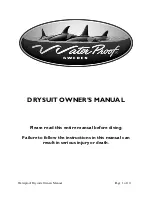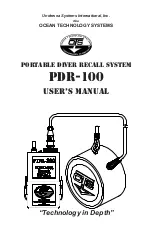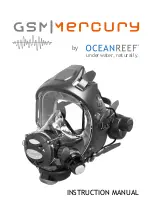
40
Maintenance
6.3.1 Cleaning
Sediment may collect in the turbidimeter body and on the overflow
weir. Algae may also form. The turbidimeter body should be drained
and flushed—on a schedule determined by visual inspection—to
remove accumulated sediment. Algae can be removed with a large
bottle brush and a sterilizing solution such as dilute chlorine bleach.
Samples containing large amounts of settleable solids may cause
frequent accumulation of solids in the turbidimeter body. To
minimize cleaning frequency, the analyzer can be operated with the
drain ball valve partially or completely open and the sample flow
increased accordingly to provide continuous flushing of solids from
the turbidimeter body. If the drain is left partially open, the ball valve
supplied should be replaced with a valve designed for flow control.
Operating the ball valve in a partially open position may damage
the valve or cause plugging of the drain line.
When used in conjunction with the Auto-flush Kit (
section 8.2 on
page 51
), the flush cycle feature may be used to operate a solenoid
valve to divert sample and provide a periodic clear water flush.
The inside enclosure of the SS7 sc can be washed down with warm
water spray if deposits accumulate inside the unit. The vent cover
at the top of the SS7 sc-HST turbidimeter body can also be
removed for cleaning as necessary.
Note:
Loosen the light source to remove or install the vent cover on the
SS7 sc-HST. Use the alignment plate included in the unit to check the
alignment of the light after installing the cover. Make sure the cover sits flat
on top of the slant tube when installed.
6.4 Unscheduled maintenance
Important Note:
Disconnect power to the instrument before
removing any cover. To reduce the possibility of ESD damage to
the equipment, avoid contact with electrical components. All
replacement components must meet or exceed original equipment
specifications to maintain applicable safety standards and
certifications and ensure proper instrument performance.
6.4.1 Lamp replacement
The lamp is located in the light source assembly block in the
sample unit. It comes with attached leads terminated in a two-pin
connector. The lamp is replaced as follows:
1.
Set the power switch in the control unit to off. Disconnect power
to the sc100 controller.
2.
Open the sample unit door. Disconnect the lamp cable at
the connector.
3.
Remove the two screws that secure the lamp source assembly
to the back plate. Remove the lamp source assembly
(
Figure 17
).
4.
Remove the four screws securing the end plate to the light
source assembly housing. Remove the end plate with gasket,
the notched spacer and the lamp.
Summary of Contents for DOC026.52.00769
Page 2: ......
Page 4: ...Visit us at www hach com...
Page 10: ...Visit us at www hach com...
Page 30: ...Visit us at www hach com...
Page 54: ...Visit us at www hach com...
Page 60: ...Visit us at www hach com...
Page 62: ...Visit us at www hach com...
Page 63: ......
Page 64: ......
















































